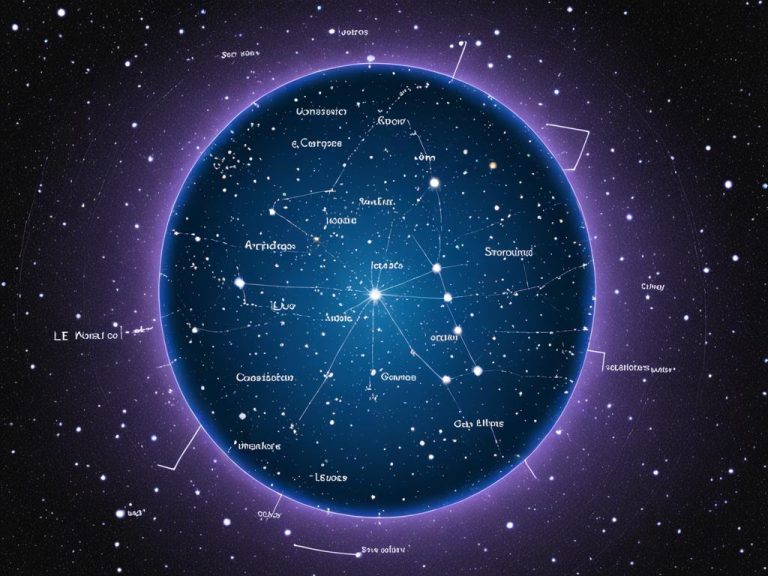Explore the Stars: Leo Minor Constellation Guide
Do you know the Leo Minor constellation, shaped like a lion, is huge in the sky? Its grand presence has amazed people looking at stars for ages. It has a rich story and many well-known stars and objects. Leo Minor is full of things waiting to be discovered.
The Greek astronomer Ptolemy first noted Leo Minor in the 2nd century. It’s brightened by stars like Regulus and Denebola, making it more fascinating. Leo Minor is famous for its sights in space. It has several galaxies, like Messier 65 and NGC 3628. These create beautiful patterns of light and matter, showing us the beauty of the universe.
Listening to Leo Minor’s story reveals an interesting tale tied to the Nemean lion. Let’s learn about the myths, famous objects, meteor showers, and where to find this amazing constellation.

Key Takeaways:
- Leo Minor is one of the largest constellations in the sky, representing the lion.
- The Greek astronomer Ptolemy first cataloged the constellation in the 2nd century.
- Regulus and Denebola are two bright stars within the Leo Minor constellation.
- The constellation is home to famous deep sky objects, including galaxies Messier 65, Messier 66, Messier 95, Messier 96, Messier 105, and NGC 3628.
- Leo Minor holds a fascinating mythological connection to the Nemean lion.
Leo Minor Constellation Facts and Information
The Leo Minor constellation is very fascinating and holds lots of interesting info. It’s the 12th biggest, covering a huge 947 square degrees in the sky. You can see it in the north, between latitudes of +90° and -65°.
It’s not alone up there. Leo Minor is next to other constellations like Cancer and Leo. This mix makes the night sky a beautiful sight for anyone looking up.
The International Astronomical Union (IAU) gave Leo Minor its simple name, Leo. This helps scientists all over the world study it. The IAU made sure of easy identification and research.
Leo Minor is big and easy to spot, making it a thrill for those who love the stars. Its size, location, plus special features, draw in people wanting to learn more. It’s truly an eye-catching focus for both beginners and experts in astronomy.
Leo Minor Constellation History
Leo Minor is full of historical meaning. People have known about it since ancient times. Evidence from Mesopotamian times around 4000 BC proves its existence. It was known by different names in various cultures, including Shir or Ser in Persian. It was UR.GU.LA, meaning “the great lion,” in Babylonian. In Syria, it was Aryo, and in Turkish, it was called Artan.
According to Greek mythology, Leo Minor is linked to the Nemean lion. This lion was slain by Heracles as one of his twelve labors.
Over the years, many have looked at Leo Minor. This has helped us learn more about the stars and the sky. The combination of its place in the heavens and its mythological significance makes it a captivating area of study.
Leo Minor Constellation Mythology
In Greek myths, the Leo Minor constellation features the Nemean lion. This lion was a menace in Nemea until Heracles beat it. It had a skin no weapon could pierce.
Heracles wrestled the lion down. He took its skin off and used it as a cape. This made him look even stronger. The stars like Regulus and Denebola are said to be parts of this lion.
Are you a fan of myths and looking at the stars? Discovering the Leo Minor constellation connects these hobbies. It brings Greek stories of bravery right above you.
Don’t forget to look at the great image below. It shows the Leo Minor constellation at its best:

Famous Stars in Leo Minor Constellation
The constellation Leo Minor has many special stars that make it beautiful. Regulus, or Alpha Leonis, is one. Its brightness, with a magnitude of 1.35, stands out. Another key star is Denebola, also known as Beta Leonis. It’s bright too, with a magnitude of 2.113.
There are more stars that make Leo Minor special. For example, Algieba (or Gamma Leonis) is known for being double. Zosma (Delta Leonis) is a yellow dwarf star that shines brightly. We also have Chort (Theta Leonis) as a significant member.
All these stars together create a beautiful nighttime view. Their light lights up the sky, making it hard to look away. To enjoy the Leo Minor stars, just look up at the night sky. Their beauty is there for all to see.
Star Naming with International Star Registry
Want a special and unique gift? Consider naming a star after someone you love. International Star Registry lets you do just that. You can give a truly amazing present.
This company has been naming stars for over 45 years. Thanks to their know-how and hard work, there are many options. You can pick a package to name a star after dear to you.
Naming a star is great for birthdays, anniversaries, graduations, or any special time. It’s a unique gift that shows your love and lasting connection.
When you name a star, you’ll get a personalized package. It includes a lovely certificate with the star’s location. You also get a map to help find your star in the sky.
Leo Minor Constellation Location and Map
Leo Minor is a star pattern in the north. It’s the 64th biggest, covering 232 square degrees. You can find it between Ursa Major and Leo, which helps people spot it easily.
To see where Leo Minor is, you can use maps from the International Astronomical Union (IAU) and trusted space books. These show where Leo Minor is compared to other star shapes. Also, sites like the Constellation Guide, Wikipedia, and EarthSky have lots of info and pictures about Leo Minor.

Leo Minor can be seen from places up to +90° and down to -40° latitude. This means most people in the north can enjoy it. Whether you’re just starting to look at stars or know a lot, finding Leo Minor is a fun sky experience.
Notable Deep Sky Objects in Leo Minor Constellation
Leo Minor is a vast place in the sky, covering 232 square degrees. It’s home to amazing deep sky objects that capture the interest of scientists and people who love the stars.
This constellation is the 64th largest, making it full of astronomical wonders.
In Leo Minor, you can see galaxies like Messier 65 and Messier 66. They are about 36 million light-years away. By looking at them, we see the beauty and complexity of space and can imagine its beginning.
Besides galaxies, Leo Minor has other fascinating things in space. You can find special celestial phenomena like Hanny’s Voorwerp and NGC 3344. Each object shows us more about the universe.
But, seeing things in Leo Minor can be hard. They might be very faint. You need a big telescope to see their full beauty and details.
Want to know more about Leo Minor’s deep sky objects? Check out these websites for extra info:
Exploring Leo Minor’s deep sky objects is amazing. It shows us the beauty and complexity of the universe.
Meteor Showers Associated with Leo Minor Constellation
The Leo Minor constellation is famous for its beauty and meteor showers. The Leonis Minorids meteor shower happens every year. It lasts from October 13 to November 3, peaking around October 20–23.
Comet C/1739 K1 is the source of Leonis Minorids. It creates a show of about 2 meteors an hour. These meteors travel at 62 kilometers per second. In 2015, a special event brought 13.9 meteors per hour on October 21.
The Leonis Minorids shower offers about 2 meteors an hour (ZHR) at its peak. In places like Andover, viewers might see 1 meteor each hour. It appears 59° above the horizon when at its best.
Certain locations face better towards meteors just before dawn, enhancing the view. Less moonlight from Cancer in its last quarter helps. This makes for a clearer sight of the meteors.
When watching the meteor shower, don’t look directly at its radiant. Instead, focus about 30–40° away. This will help you see more meteors and enjoy the scene.
If you want to know more about the Leonis Minorids and Leo Minor, check out: Leonis Minorids, in-the-sky.org..
Conclusion
The Leo Minor constellation was discovered by Johannes Hevelius in the 17th century. It’s a fascinating area in the night sky. It sits between Leo and Ursa Major. Even though it’s faint, it’s full of interesting stars and objects.
Leo Minor has five main stars, with the bright Praecipua standing out. This pattern is always visible from Ireland. That makes it a great spot for looking up at the stars.
If you name a star in Leo Minor with International Star Registry, you give an unforgettable present. Follow in the steps of Busy Philipps, who has a star there. Discover the wonder of the cosmos.
There are many hidden gems in the Leo Minor, like the Leo Ring and M92. Plus, it’s tied to interesting myths. Begin an adventure under Leo Minor’s stars. You’ll make memories that last a lifetime.
FAQ
What is the Leo Minor constellation?
The Leo Minor constellation is big in the sky. It looks like a lion. This connects to the Nemean lion in Greek stories. You can see bright stars like Regulus and Denebola in it.
How large is the Leo Minor constellation?
The Leo Minor covers 947 square degrees. This makes it the 12th biggest in the night sky.
Where is the Leo Minor constellation located?
You can spot the Leo Minor in the north. It’s between +90° and -65° latitude. It’s next to other constellations like Cancer and Leo Minor, among others.
What is the historical significance of the Leo Minor constellation?
People have known about Leo Minor for ages. Evidence goes back to 4000 BC. It was named differently by various cultures. The Nemean lion from Greek myths is tied to it.
Can I name a star after someone in the Leo Minor constellation?
Yes, you can through International Star Registry. They have many naming packages. It’s great for special occasions.
Where can I find the Leo Minor constellation on a map?
Look at maps from the International Astronomical Union. They make finding Leo Minor easy and accurate.
What are the famous deep sky objects in the Leo Minor constellation?
Don’t miss galaxies like Messier 65 and Messier 66. There’s also Messier 95, 96, 105, and NGC 3628.
Are there any meteor showers associated with the Leo Minor constellation?
Yes, the Leonids happen on November 17-18. The January Leonids peak between January 1 and 7.
Source Links
- Stars, Facts, Myth, Location… – Constellation Guide – https://www.constellation-guide.com/constellation-list/leo-constellation/
- Leo Constellation: Facts About the Lion – https://www.space.com/16845-leo-constellation.html
- Leo Minor | Constellation, Stars, Galaxies – https://www.britannica.com/place/Leo-Minor
